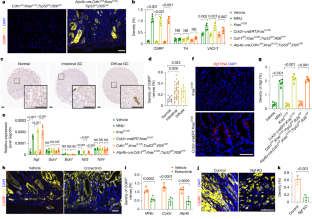2025-02-19 コロンビア大学
<関連情報>
- https://www.cuimc.columbia.edu/news/nerves-electrify-stomach-cancer-sparking-growth-and-spread
- https://www.nature.com/articles/s41586-025-08591-1
侵害受容性ニューロンはCGRP-RAMP1軸を介して胃腫瘍の進行を促進する Nociceptive neurons promote gastric tumour progression via a CGRP–RAMP1 axis
Xiaofei Zhi,Feijing Wu,Jin Qian,Yosuke Ochiai,Guodong Lian,Ermanno Malagola,Biyun Zheng,Ruhong Tu,Yi Zeng,Hiroki Kobayashi,Zhangchuan Xia,Ruizhi Wang,Yueqing Peng,Qiongyu Shi,Duan Chen,Sandra W. Ryeom & Timothy C. Wang
Nature Published:19 February 2025
DOI:https://doi.org/10.1038/s41586-025-08591-1

Abstract
Cancer cells have been shown to exploit neurons to modulate their survival and growth, including through the establishment of neural circuits within the central nervous system1,2,3. Here we report a distinct pattern of cancer–nerve interactions between the peripheral nervous system and gastric cancer. In multiple mouse models of gastric cancer, nociceptive nerves demonstrated the greatest degree of nerve expansion in an NGF-dependent manner. Neural tracing identified CGRP+ peptidergic neurons as the primary gastric sensory neurons. Three-dimensional co-culture models showed that sensory neurons directly connect with gastric cancer spheroids. Chemogenetic activation of sensory neurons induced the release of calcium into the cytoplasm of cancer cells, promoting tumour growth and metastasis. Pharmacological ablation of sensory neurons or treatment with CGRP inhibitors suppressed tumour growth and extended survival. Depolarization of gastric tumour membranes through in vivo optogenetic activation led to enhanced calcium flux in jugular nucleus complex and CGRP release, defining a cancer cell–peptidergic neuronal circuit. Together, these findings establish the functional connectivity between cancer and sensory neurons, identifying this pathway as a potential therapeutic target.


